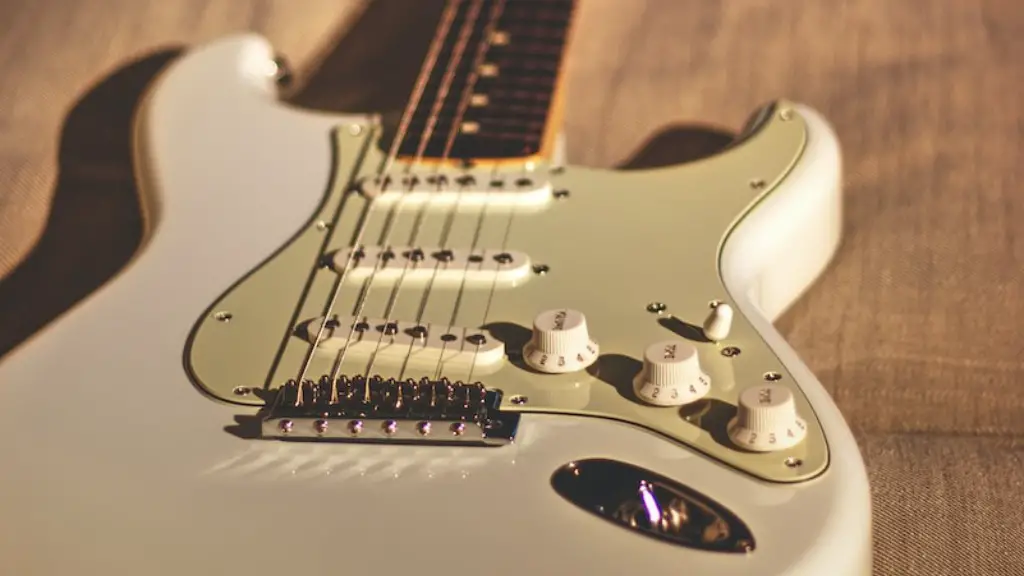Learning how to reduce action on electric guitar is an important part of owning and playing the instrument. The action refers to the distance between the strings and the fretboard, and it affects the feel of playing, sound quality, and even intonation. An electric guitar with a high action is difficult to play and can cause buzzing or fretting out.
It is possible to lower the action on your electric guitar yourself with some basic tools, however it is recommended that you seek professional help if you are not comfortable doing it yourself. This article will provide you with a step-by-step guide on how to reduce action on an electric guitar.
It is important to prepare your electric guitar for this process by cleaning all of its parts. This includes wiping down the neck and body with a cloth as well as cleaning all of the strings with a string cleaner. Once this is done, you can proceed to adjusting the action. You will need a few tools for this such as an adjustable wrench, hex key set, and screwdrivers.
With these basic tools, you can begin to adjust your electric guitar’s action by carefully turning the truss rod nut or adjusting the bridge height. Following these steps will ensure that your instrument has a low action that is comfortable for playing.
Understanding Truss Rods
The truss rod is a metal rod found inside the neck of an electric guitar, used to adjust the shape of the neck and the string action. Adjusting the truss rod can reduce the action of your strings, allowing them to be lower and easier to play. When adjusting a truss rod, it is important to take small steps and adjust gradually until you achieve the desired action. It is important to note that adjusting a truss rod too much can cause serious damage to your guitar.
To adjust a truss rod, begin by loosening it. Use an appropriate sized hex key for your guitar and turn it counter-clockwise until it feels loose. Once it is loose, use a ruler or straight edge to check if there are any bends in the neck. If there are, use small adjustments of the truss rod to bring back into shape. When finished, you may need to tune your guitar again as the tension in the strings can be affected by changes in action.
Finally, once you have achieved your desired action level on your electric guitar, remember to always keep an eye on it and make adjustments as necessary over time. With regular maintenance and some patience, you can keep your guitar playing great for years!
Adjusting the Bridge Pickup Height
Adjusting the bridge pickup height on an electric guitar is an effective way to reduce the overall action. The bridge pickup is the main source of sound for the guitar, and adjusting its height can make a big difference to how easy it is to play. To adjust the pickup height, you’ll need to loosen the screws on either side of the pickup and then use a small screwdriver or allen key to raise or lower it as needed. Make sure not to raise it too high, as this can cause feedback or buzzing sounds. Be sure to check for string buzz when you’re done.
Once you’ve adjusted the bridge pickup height, you’ll want to check the action of your guitar by playing each string along its entire length. If there is still too much action, you may need to adjust the truss rod (usually found in the neck) or even replace your strings with lighter-gauge ones. With patience and care, you can achieve a low action that will make playing your electric guitar easier and more enjoyable.
Checking the Guitar Neck Relief
A guitar’s neck relief refers to the amount of space between the strings and the fretboard. If this space is too large, it can cause buzzing and increased action on electric guitars. To reduce action, you must adjust the neck relief. This can involve adjusting the truss rod, raising or lowering the bridge saddles, and checking intonation.
Start by loosening the strings on your guitar and then adjusting the truss rod nut to increase or decrease tension in the neck. This will affect how much relief is present in the neck. With a capo on the first fret, check for any buzz when you play each string at different frets up to 12th fret. If necessary, make further adjustments until there is no buzzing at any point up to 12th fret.
Next, you must check and adjust saddle heights at each string if needed. To do this, use a feeler gauge and check for any gaps between it and each saddle top. Once all gaps are eliminated, use a ruler to check if all saddles are even. Finally, recheck intonation with an electronic tuner to ensure all notes are accurate throughout each string’s range.
Setting Up Your Electric Guitar
Adjusting the action on your electric guitar is a great way to improve the playability of your instrument. The action is the distance between the strings and the fretboard, and when it’s too high, it can be difficult to press down on the strings. Lowering the action can make your guitar easier to play. To reduce action on an electric guitar, you’ll need a few simple tools and some patience.
First, start by loosening the strings and removing them from the tuning pegs. Next, loosen up the truss rod by turning it counter-clockwise with an appropriate wrench. Don’t over-tighten or loosen this rod as it could cause your guitar to become permanently damaged. Once you’ve adjusted the truss rod, you’ll need to adjust each individual saddle on your bridge. You can do this by adjusting each saddle up or down until all of them are level with one another.
Finally, re-thread your strings onto your tuning pegs and tune them up. Make sure that all of your notes are in tune before playing as this will affect how low or high your action is set at. Be sure to check the intonation of each string after setting up your electric guitar – this will ensure that each note sounds accurate and clear when you strum chords or play single notes. With a few simple adjustments, you can reduce action on an electric guitar for a more comfortable and enjoyable playing experience!
Choosing a Lighter Gauge Strings to Reduce Action on Electric Guitar
Guitar string gauge is an important factor when it comes to playability and the feel of your guitar. Lighter gauge strings are generally easier to press down, and they help reduce the action on your electric guitar. If you’re looking for a more comfortable playing experience, then lighter gauge strings can be a great solution. Lighter gauge strings also offer more clarity and brighter tones, which can be beneficial for certain styles of playing.
When selecting lighter gauge strings, be sure to take into account the type of guitar you have, what kind of sound you’re trying to achieve, and the type of playing you do. For instance, if you have a heavier instrument with thicker strings, using lighter strings may help reduce some of the tension while still keeping your sound intact. Likewise, if you want a brighter tone from your guitar, lighter gauge strings may provide just what you need.
If you’re unsure about which string gauge is best for your setup, it’s always best to consult with an experienced luthier or guitar tech who can help guide your decision. With the proper advice and setup, lighter gauge strings can make all the difference in improving playability and overall sound quality.
Adjusting Nut Slots Properly
Adjusting the nut slots of your electric guitar is an important part of setting up and maintaining your instrument. It involves filing down the slots in the nut, which are where the strings rest, so that they sit at the correct height above the fretboard. This process can help reduce action, or string height, and give you a better playing experience.
To start, you’ll need a set of nut files in various sizes and shapes to match each string slot. You’ll also need some sandpaper or a fine-grit file to smooth out any rough edges after filing. Begin by loosening all the strings on your guitar and removing them from the headstock. Then, use your nut files to carefully remove small amounts of material from each slot until they’re at an even height with one another. Be sure to test your work frequently with a ruler or feeler gauge so you don’t remove too much material.
Once all slots are at an even height, lightly sand or file any rough edges for a smooth finish. To finish off, re-string your guitar and adjust the truss rod as needed for proper action on all strings. With proper setup and maintenance, you can ensure that your electric guitar will sound great for years to come!
The End
Reducing action on electric guitar is an important step to ensure the best sound quality and playability of the instrument. It can be done in a few simple steps at home or with the help of a professional. Properly adjusting the truss rod, bridge, and intonation should be done to ensure that the strings don’t buzz or fret out. To ensure optimal performance, it is important to check the action regularly and make adjustments as needed. By following these steps, guitarists can improve their sound and playing experience.





